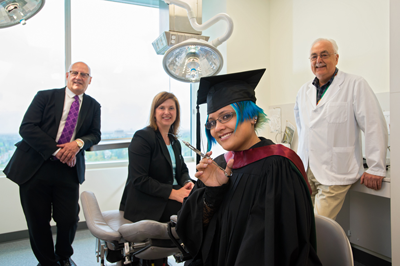
Aislinn Khuong with the three dentistry mentors who helped her beat her fear of needles: (from left) David Kelner, Ronna Lozano and Tom Stevenson (Photo: Richard Siemens)
The tiny line tattoos on her thumb and fingers have faded now, but the confidence they represent is here to stay for new dentist Aislinn Khuong.
Without the tattoos and a caring team of mentors from the University of Alberta Faculty of Medicine & Dentistry, Khuong, 26, might not be graduating June 6 with a Doctor of Dental Surgery, preparing to join her dad in his Calgary practice.
"If it wasn't for the help of three wonderful people, I would not be graduating," Khuong said. "It was a team effort, and overcoming a lifelong phobia is no small feat. It's a testament to the quality of support I had here at the U of A."
The trio of faculty members-Tom Stevenson, David Kelner and Ronna Lozano-all supported Khuong in various ways to help her overcome a lifelong phobia of needles, so she could learn to administer local anesthetic to dental patients. "They are a team of people who had the power to change my life."
Khuong's fear stemmed from an early childhood incident, when as a sick and dehydrated two-year-old, her veins kept collapsing as nurses struggled to insert an IV. "I have a vague memory of them trying to give me a needle over and over."
When the time came in her second-year anesthesia course to give an injection herself, Khuong panicked. "I didn't even want to come into the room. I cried for 45 minutes after the first session."
Khuong had known she wanted to follow in her dad's footsteps as a dentist, so didn't dwell on her fear of needles until she had to face it full-on. "I never saw it stopping me, but I also didn't want to think about it."
When the time came, faculty were there to help. Khuong said Stevenson, division head of oral surgery, "empathized, supervised and followed through with me. He was there, he walked beside me through the whole course. It made me feel looked after and supported."
It was rewarding to see Khuong's confidence growing as she overcame her fear, Stevenson said.
"Her success with this phobia was because of her determination, hard work and refusal to fail," he said. "This was a long and difficult journey for her, and it was my good fortune that I had the opportunity to help." The crowning moment for Stevenson came about six months after the course ended. "I was walking through the clinic and Aislinn had just finished injecting a patient. As I was walking by, she gave me a discreet thumbs-up."
Lozano, the school's nurse, provided a listening ear and led Khuong through a logical thought process about local anesthesia. "By her fourth year, I had all but forgotten about Aislinn's initial injecting phobia," Lozano says now. "She was confident and competent in all aspects with her patients, and she will be a caring and thoughtful dentist."
Khuong was also helped by David Kelner, associate professor of restorative dentistry, who in private practice, assists patients with managing their fears and phobias and taught Khuong and her classmates about the use of hypnosis.
When she approached him after class to confide about her fear of needles, Kelner sensed her relief when he told her hypnotherapy could likely help.
She took some sessions, and was happy to report back to Kelner about her success.
"I will always remember the big sense of relief she had and the big smile on her face," Kelner said. "Aislinn serves as an example to us all to engage and conquer our fears."
It was a hypnotherapist, in fact, who suggested the idea of a tattoo.
Designed by Khuong, the tattoos offer her a visual reminder of how she overcame her fears about giving injections. Inked onto her thumb and two fingers where the syringe rests, the artwork is "a place on my body where this needle belongs, and I am in control of it. It represents me being free of the needle phobia."
Today, two years after she triumphed over the dreaded anesthesia course, she gives injections with a steady hand-and more importantly, a kind heart, which reflects her purpose as a dentist.
"Dentistry and anesthesia are about relieving pain. I know when I have patients who are scared of dentists or needles, I'm glad that they are in my chair, because I know that this is a safe place for them to be, and I'm grateful for the chance to make the experience less traumatic for them."